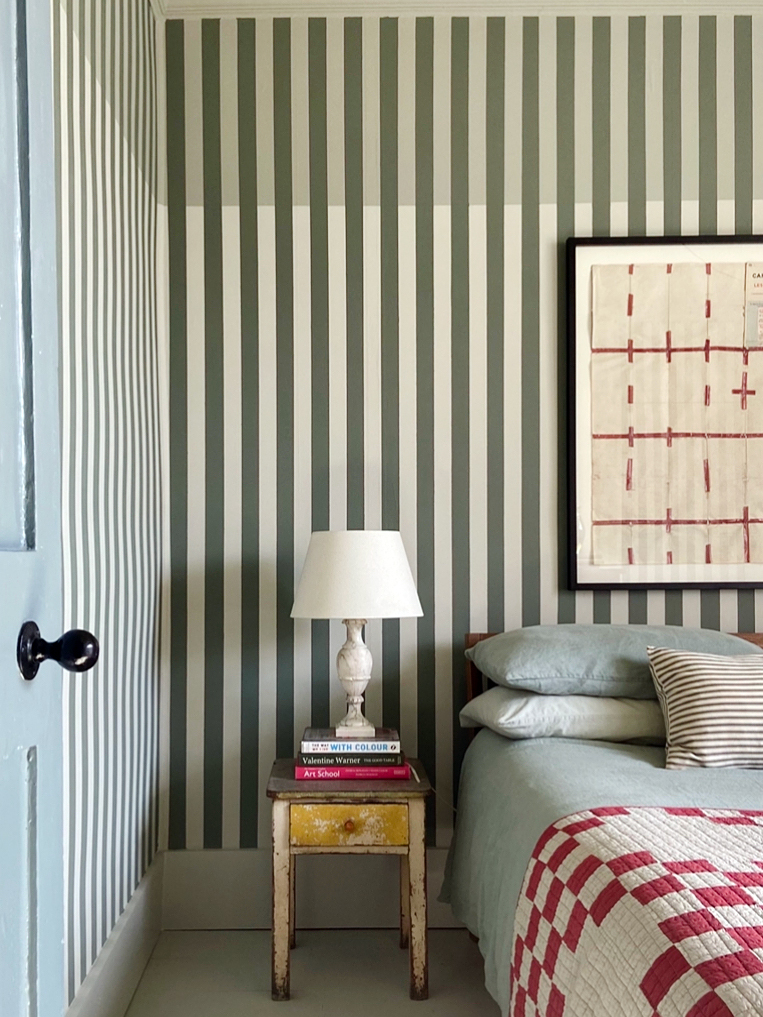We may earn revenue from the products available on this page and participate in affiliate programs.
Wallpaper can be pricey, especially if you’re like artist Russell Loughlan and a gut renovation is eating into your budget. But if graphic stripes are what you’re after, Loughlan found a solution: hand-paint them himself. Hand-painting requires some patience—it took four days just to line up the tape correctly—but the result is a well-earned wow factor.
Just ask Loughlan’s neighbor, Jessie Cutts, who recently painted her powder room in marigold and cream. “With a lot of encouragement from Russell, I would do an hour, or sometimes even half an hour, at a time, because that’s the only way I could fit it in,” she explained in an Instagram caption. “At times it’s definitely frustrating, but also, what’s the rush?”

With a combo of a ruler, level, and old-school string with a coin tied to the end, Loughlan began the process of measuring out the 2-inch spaces between each line. (Tip: It’s the standard width of wide painter’s tape.) So many straightedges were needed because his old Georgian walls aren’t even—not one 90-degree angle in sight.
If your ceilings (or floors) are equally wonky, create a truly straight guideline with a level laser pointed horizontally across the wall you’re working on. Once that baseline is established, you can go in with a vertical level (or coin-weighted string) and a ruler to pencil in the stripes from ceiling to baseboard. When you’re ready to apply the tape, the pencil marks act as a guide for keeping the lines straight. Take a step back periodically to ensure you’re not getting tunnel vision—what seems perfectly linear close-up could actually be crooked.
After decking out his bedroom and bathroom in different variations of two-tones stripes, Loughlan has a few tips to keep everything on track.
Peel Back the Tape

Even the highest quality painter’s tape can result in color bleeding through if you’re not careful. By pulling the tape off a few minutes after you finish the second coat, the color won’t get a chance to seep under the edges. But if there are some splotches, Loughlan recommends going in with a very small sponge brush or honestly just leaving it alone. “You’re hand-painting for a reason,” he says. “The imperfections are part of the charm.”
When in Doubt, Size Up
Thinner stripes, like a pinstripe, show imperfections and wobbly lines more than thicker ones, he notes. Little 1-inch lines also create more of a hypnotic visual effect, not recommended for tight or dark spaces. If you don’t trust the steadiness of your hands—or just want a little more forgiveness—stick to a 2- or 3-inch width.
Patience Makes Perfect
Unless you’re working around the clock, this won’t be a quick project. It took Cutts weeks to complete her 6-foot bathroom, all while managing two young kids and a full-time job. However, the process is so meditative that it can be addicting. It’s what motivated Loughlan to continue past the original plan of one accent wall to all four.
